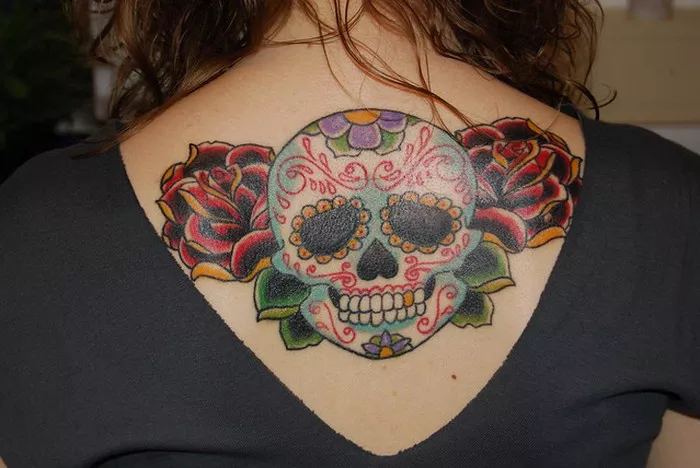Sugar skull tattoos have emerged as a prominent and visually striking motif in the world of body art. Originating from Mexican culture, these intricate designs have transcended geographical boundaries, becoming popular among tattoo enthusiasts worldwide. Beyond their aesthetic appeal, sugar skull tattoos carry profound symbolism deeply rooted in tradition and heritage. In this comprehensive exploration, we delve into the rich cultural significance behind sugar skull tattoos, unraveling their meanings, history, and contemporary interpretations.
Understanding the Origins: A Journey into Mexican Tradition
To comprehend the symbolism of sugar skull tattoos, it’s essential to delve into their cultural origins. Rooted in the vibrant traditions of Mexico, sugar skulls, also known as calaveras, hold a central place in the celebration of Día de los Muertos, or Day of the Dead. This annual festivity, observed on November 1st and 2nd, honors deceased loved ones, blending indigenous Aztec rituals with Catholic influences brought by Spanish colonizers.
During Día de los Muertos, families create altars adorned with offerings such as marigolds, candles, and, notably, sugar skulls. These intricately decorated confections serve as sweet tributes to departed souls, symbolizing the cyclical nature of life and death. The practice of adorning skulls with colorful embellishments reflects the Mexican belief that death should be celebrated as a natural part of the human experience rather than feared.
Symbolism and Significance: Decoding Sugar Skull Tattoos
In the realm of body art, sugar skull tattoos serve as powerful symbols laden with meaning. While interpretations may vary based on individual perspectives, several recurring themes underscore the significance of these tattoos:
1. Celebration of Life and Death: At its core, the sugar skull tattoo pays homage to the Mexican philosophy of embracing mortality as an integral aspect of existence. By immortalizing these vibrant symbols on their bodies, individuals honor the interconnectedness of life and death, viewing the cycle as a cause for celebration rather than sorrow.
2. Remembrance and Tribute: Sugar skull tattoos often serve as poignant memorials to loved ones who have passed away. By adorning their skin with these intricate designs, wearers commemorate the memory of departed friends or family members, keeping their spirits alive through the artistry of tattooing.
3. Cultural Identity and Pride: For individuals with Mexican heritage, sugar skull tattoos can represent a profound connection to their cultural roots. These tattoos serve as visual affirmations of identity, celebrating the rich tapestry of Mexican traditions and values passed down through generations.
4. Transformation and Rebirth: In some interpretations, sugar skull tattoos symbolize the transformative journey of the soul beyond physical death. Just as the sugar skull undergoes a metamorphosis from simple ingredients to a dazzling work of art, individuals see themselves as evolving beings transcending the constraints of mortality.
5. Defiance of Death’s Grimness: Despite their association with mortality, sugar skull tattoos exude vibrancy and vitality, challenging conventional notions of death as dark and foreboding. Through bold colors, intricate patterns, and ornate decorations, these tattoos defy the grimness often associated with death, embracing a more lighthearted and celebratory perspective.
Exploring Artistic Expression: Variations and Styles
While traditional sugar skull tattoos feature ornate designs inspired by Mexican folk art, contemporary interpretations have expanded the aesthetic possibilities, giving rise to a diverse array of styles and motifs. Some popular variations include:
1. Realism: For those seeking a more lifelike depiction, realism-inspired sugar skull tattoos capture intricate details with precision, showcasing the delicate lines and contours of the skull’s anatomy.
2. Neo-Traditional: Combining elements of traditional tattooing with modern techniques, neo-traditional sugar skull tattoos infuse classic motifs with bold colors and dynamic compositions, offering a fresh take on a timeless symbol.
3. Blackwork: Characterized by bold, black ink and intricate linework, blackwork sugar skull tattoos make a bold statement with their stark contrast and minimalist aesthetic.
4. Watercolor: Embracing the fluidity of watercolor painting, these tattoos feature vibrant splashes of color, creating a visually stunning effect reminiscent of a painted canvas.
5. Geometric: Drawing inspiration from geometric shapes and patterns, geometric sugar skull tattoos offer a contemporary spin on traditional imagery, with clean lines and symmetrical designs.
Navigating Cultural Sensitivity: Appropriation vs. Appreciation
As sugar skull tattoos gain popularity beyond Mexican borders, questions of cultural appropriation and sensitivity come to the fore. While many individuals embrace these tattoos as a form of artistic expression and homage to Mexican culture, others caution against trivializing or commodifying sacred symbols.
It’s crucial for tattoo enthusiasts to approach sugar skull tattoos with respect and awareness of their cultural significance. This entails educating oneself about the traditions and meanings behind these symbols, engaging in meaningful dialogue with members of the Mexican community, and avoiding caricatured or stereotypical representations.
By fostering a culture of appreciation rather than appropriation, individuals can celebrate the beauty and depth of Mexican heritage while honoring its cultural significance with integrity and reverence.
Conclusion
In the realm of body art, sugar skull tattoos stand as poignant reminders of the interconnectedness of life and death, celebrating the vibrancy of Mexican tradition while honoring the memories of loved ones past. From their origins in Día de los Muertos to their contemporary manifestations in tattoo studios worldwide, these intricate symbols continue to captivate hearts and minds, offering profound insights into the human experience.
As individuals adorn their bodies with sugar skull tattoos, they not only embrace a timeless tradition but also embark on a deeply personal journey of remembrance, transformation, and cultural connection. In each stroke of ink, the essence of life’s fleeting beauty is captured, inviting us to cherish the present moment and celebrate the eternal dance of existence.
In the end, a sugar skull tattoo is more than just a work of art—it’s a testament to the enduring legacy of those we hold dear and a celebration of the kaleidoscope of life in all its colorful splendor.

